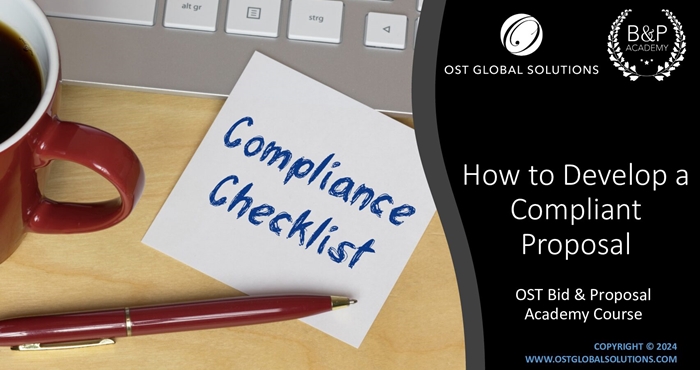Description
A great outline reduces stress and rework during the proposal development process. It helps direct the authors, and integrate the proposal from the start.
The course subsequently delves into when use of storyboards (or writers’ work packages) is more appropriate than annotated outlines, and vice versa. It shows how to develop storyboards the right way, avoiding the typical problems companies face with storyboard development.
This course is for those in the Proposal Management, Proposal Writing, and Proposal Coordination fields. It will teach professional skills in annotated outlines and storyboard development. In the course, attendants will explore the outlining topic in a greater depth than in our Foundations of Proposal Management and Writing Persuasive Federal Proposals courses. It addresses the typical areas of struggle for proposal practitioners through individual and group work in a “roll-up-your-sleeves and put the new skills to practice” workshop format. The course zooms in on the nuance of outline and storyboard building that’s a hallmark of true proposal professionals.
This interactive two-day workshop is 20 percent lecture, 70 percent practical exercises, and 10 percent discussion.
The experts who teach our business development, capture and proposal training are highly experienced currently practicing proposal professionals whose years of successful experience in Government acquisition and training allow them to offer valuable insights to our students. Our instructors can answer tough questions as they come up during the course. They can also tailor the material to their students’ specific challenges, and share their experience based on the most current realities. Check our instructor’s bios on our About Us page.
Course Curriculum
Learning Objectives:
Upon course completion, the participants will have learned and be able to put into practice:
- Understanding how properly annotated outlines help reduce stress in proposals and get a higher score with evaluators
- Navigating different types of RFX structures like a professional
- Mastering the techniques for structuring proposal outlines correctly
- Setting up compliance matrixes
- Developing cross-reference matrixes
- Developing compliance checklists
- Allocating the page count correctly
- Developing effective resumes and past performance templates
- Setting up outlines for business and cost volumes
- Creating useful annotations to guide the authors
- Incorporating proposal mock-up elements into the outline
- Incorporating section flow into the outline
- Reviewing and refining the outline
- Issuing assignments to the authors using an annotated outline
- Navigating through the pros and cons of working with storyboards and writers’ work packages
- Deciding when to use storyboards
- Setting up the storyboards correctly for the writers to eliminate typical storyboard breakdowns
Module 1: Introduction
- Introductions and learning objectives
- Overview of where outlining and storyboarding fit within the proposal process
- How annotated outlines help reduce stress in proposals and get a higher score with evaluators
Module 2: Navigating RFPs and RFQs
- How to read an RFP or RFQ
- Different types of RFX structures (including Task Order RFPs), and how to navigate them successfully
- How to decide what sections are important for compliant outlining and what sections are part of a contractual document and therefore don’t require proposal mention.
Exercise: Identify sections pertinent to outlining in different types of RFPs and RFQs.
Module 3: Structuring Proposal Outlines
- Techniques for structuring proposal outlines correctly
- Sources of information and degrees of their reliability.
- Proposal outlines hierarchy
- Telling a story while remaining compliant
- Deciding on the outline structure
- Allocating page counts correctly
Exercise: Decide on the top-level outline structure for a practice proposal.
Module 4: Ensuring Compliance
- The difference between compliance matrixes, cross-reference matrixes, and compliance checklists, and how to use each one correctly
- Other techniques for showing compliance in a proposal document
- How to set up a compliance matrix
- How to develop a cross-reference matrix
- How to develop a compliance checklist
Exercise: Develop a cross-reference matrix for the practice proposal.
Module 5: Developing Resume and Past Performance Templates and Other Volumes
- How to develop effective resume templates
- How to design compliant and compelling past performance templates
- Setting up outlines for business volume
- Setting up outlines for the cost volume
Exercise: Set up a past performance template, resume template, and business volume outline for the practice proposal.
Module 6: Transforming the Topical Proposal Outline into an Annotated Outline
- Creating useful annotations to guide the authors
- Incorporating proposal mock-up elements into the outline
- Incorporating section flow into the outline
- Reviewing and refining the outline
- Issuing assignments to the authors using an annotated outline
Exercise: Annotate the practice proposal outline.
Module 7: Creating Proposal Storyboards and Work Packages
- The pros and cons of working with storyboards and writers’ work packages
- Deciding when to use storyboards
- Setting up the storyboards correctly for the writers to eliminate typical storyboard breakdowns
Exercise: Create a writer’s work package for the practice proposal.
Module 8: Summary and Recap
Meet Your Instructor
 Olessia Smotrova, CF.APMP Fellow
Olessia Smotrova, CF.APMP Fellow
Olessia has more than 25 years of experience in business development. She led winning bids for four out of the top five Government contractors, winning more than $26 billion over the course of her career in single award contracts. She is an AI developer and strategist, pioneering the use of generative AI in Government contracting. She has created and implemented AI tools for business development processes, proposal strategy formulation, and competitive analysis. She is an AI super-user and thought leader in the practical application of generative AI in synthesizing complex data, generating innovative solutions, and driving decision-making in high-stakes Government BD environments.
She is the author of the book How to Get Government Contracts: Have a Slice of $1 Trillion Pie and seven other books. She has taught a graduate course for the Stevens Institute of Technology, and she provided training to Treasury and NASA. She has served for 2 years as the President of the National Contracts Management Association (NCMA) Bethesda/Medical Chapter and for 2 years as the President of the Association of Proposal Management Professionals (APMP) National Capital Area Chapter.
Olessia is recognized as an APMP Fellow for her contributions to the field of capture and proposals – the highest honor in the business development profession. Her skills span every aspect of business development, sales, and marketing. Prior to supporting Fortune 500 companies and small businesses as a proposal consultant and growing OST, she worked as a business developer for Raytheon and Lockheed Martin and wrote for the Financial Times of London.

















